CHEVROLET TRACKER 1993 Owners Manual
Manufacturer: CHEVROLET, Model Year: 1993, Model line: TRACKER, Model: CHEVROLET TRACKER 1993Pages: 339, PDF Size: 15.75 MB
Page 181 of 339
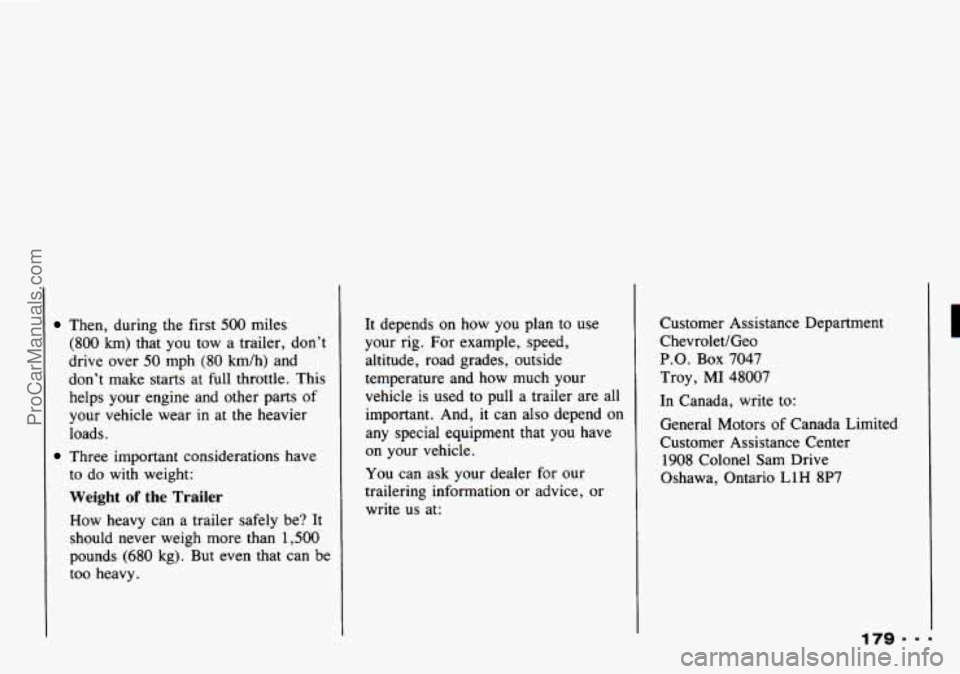
Then, during the first 500 miles
(800 km) that you tow a trailer, don’t
drive over
50 mph (80 h/h) and
don’t make starts at full throttle. This
helps your engine and other parts
of
your vehicle wear in at the heavier
loads.
Three important considerations have
to
do with weight:
Weight of the Trailer
How heavy can a trailer safely be? It
should never weigh more than
1,500
pounds (680 kg). But even that can be
too heavy. It depends on
how you plan to
use
your rig. For example, speed,
altitude, road grades, outside
temperature and how much your
vehicle
is used to pull a trailer are all
important. And, it can also depend on
any special equipment that you have
on your vehicle.
You can ask your dealer for our
trailering information
or advice, or
write
us at: Customer
Assistance Department
Chevrolet/Geo
P.O. Box 7047
Troy, MI 48007
In Canada, write to:
General Motors of Canada Limited
Customer Assistance Center
1908 Colonel Sam Drive
Oshawa, Ontario
L1H 8P7
ProCarManuals.com
Page 182 of 339
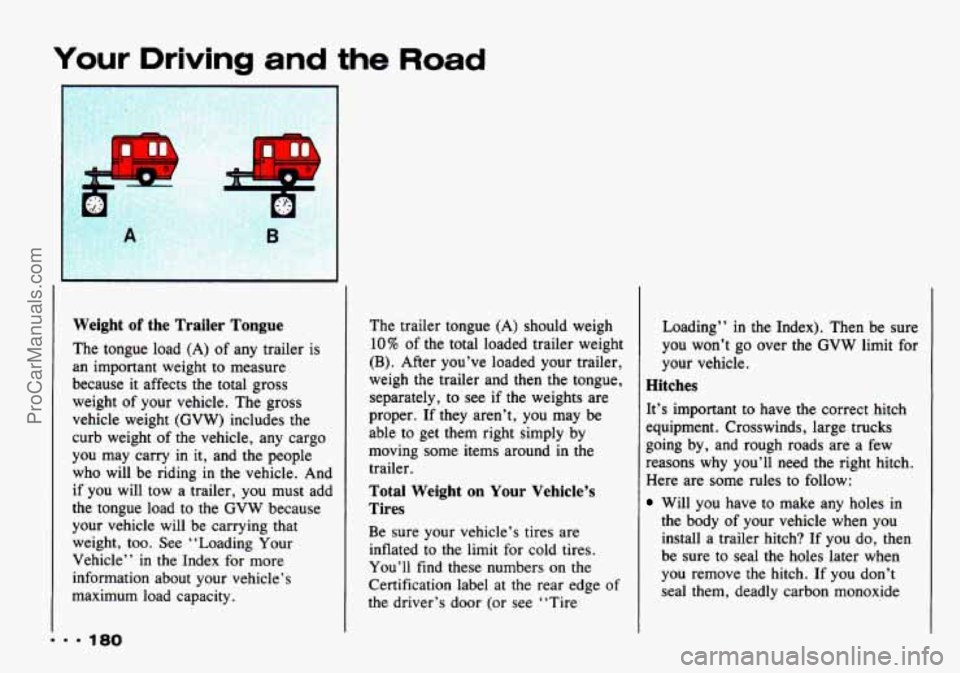
Your Driving and the Road
L
Weight of the Trailer Tongue
... 180
The tongue load (A) of any trailer is
an important weight to measure
because
it affects the total gross
weight of your vehicle. The gross
vehicle weight (GVW) includes the
curb weight of the vehicle, any cargo
you may carry in it, and the people
who will be riding in the vehicle. And
if
you will tow a trailer, you must add
the tongue load to
the GVW because
your vehicle will be carrying that
weight, too. See “Loading Your
Vehicle’’ in the Index for more
information about your vehicle’s
maximum load capacity. The trailer
tongue (A) should weigh
10%
of the total loaded trailer weight
(B). After you’ve loaded your trailer,
weigh the trailer and then the tongue,
separately, to see if the weights are
proper. If they aren’t, you may be
able to get them right simply by
moving some items around in the
trailer.
Total Weight on Your Vehicle’s
Tires
Be sure your vehicle’s tires are
inflated to the limit for cold tires.
You’ll
find these numbers on the
Certification label at the rear edge of
the driver’s door (or see “Tire Loading”
in the Index). Then be sure
you won’t go over the GVW limit for
your vehicle.
Hitches
It’s important to have the correct hitch
equipment. Crosswinds, large trucks
going by, and rough roads are a few
reasons why you’ll need the right hitch.
Here are some rules to follow:
Will you have to make any holes in
the body of your vehicle when
you
install a trailer hitch? If you do, then
be sure to seal
the holes later when
you remove the hitch. If you don’t
seal them, deadly carbon monoxide
ProCarManuals.com
Page 183 of 339
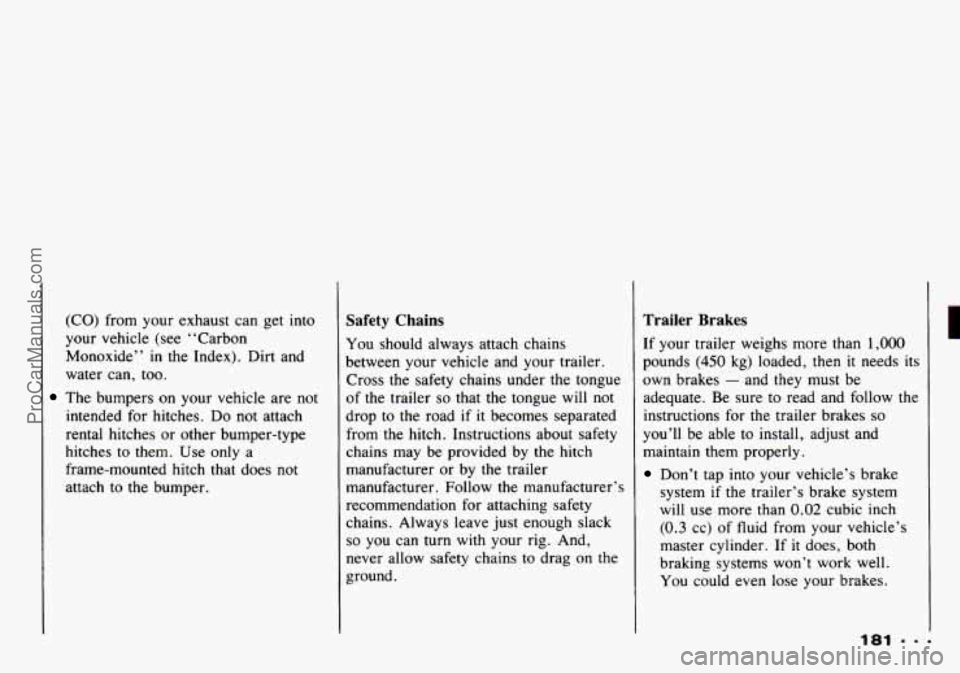
(CO) from your exhaust can get into
your vehicle (see “Carbon
Monoxide’’
in the Index). Dirt and
water can, too.
The bumpers on your vehicle are not
intended for hitches.
Do not attach
rental hitches or other bumper-type
hitches to them. Use only a
frame-mounted hitch that does
not
attach to the bumper.
Safety Chains
You should always attach chains
between your vehicle and your trailer.
Cross the safety chains under the tongue
of
the trailer so that the tongue will not
drop to
the road if it becomes separated
from
the hitch. Instructions about safety
chains may be provided by
the hitch
manufacturer or by the trailer
manufacturer. Follow
the manufacturer’s
recommendation for attaching safety
chains. Always leave just enough slack
so you can turn with your rig. And,
never allow safety chains to drag
on the
ground.
Trailer Brakes
If your trailer weighs more than 1,000
pounds (450 kg) loaded, then it needs its
own brakes
- and they must be
adequate. Be sure
to read and follow the
instructions for the trailer brakes
so
you’ll be able to install, adjust and
maintain them properly.
Don’t tap into your vehicle’s brake
system if the trailer’s brake system
will use more than
0.02 cubic inch
(0.3 cc) of fluid from your vehicle’s
master cylinder. If
it does, both
braking systems won’t work well.
You could even lose your brakes.
ProCarManuals.com
Page 184 of 339
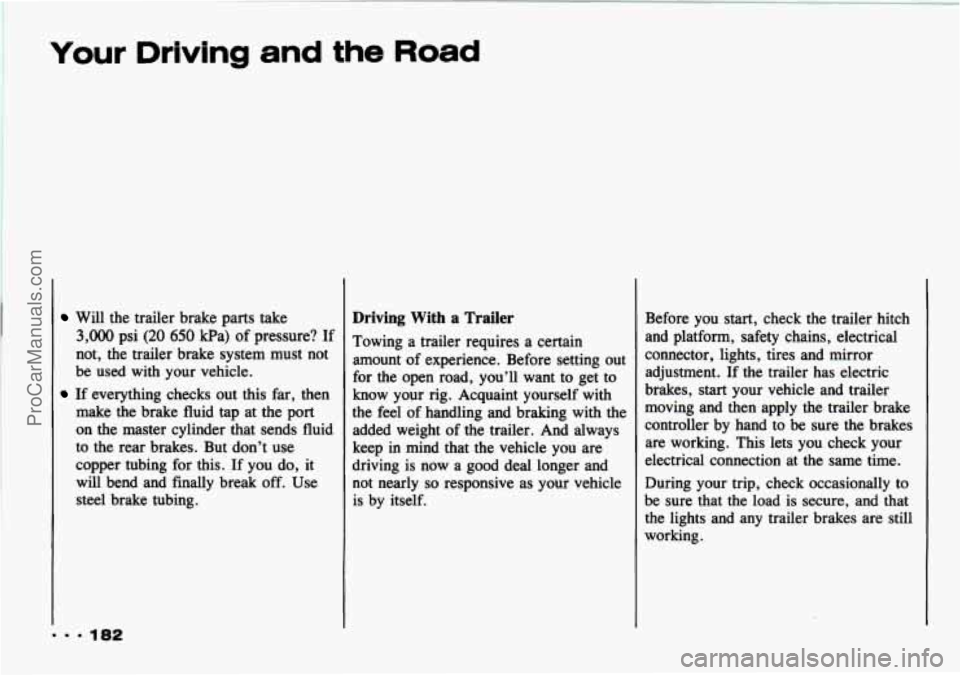
Your Driving and the Road
Will the trailer brake parts take
3,000 psi (20 650 kPa) of pressure? If
not, the trailer brake system must not
be used with your vehicle.
If everything checks out this far, then
make the brake fluid tap at the port
on the master cylinder that sends fluid
to the rear brakes. But don’t use
copper tubing
for this. If you do, it
will bend and finally break off. Use
steel brake tubing.
88. 182
Driving With a Trailer
Towing a trailer requires a certain
amount
of experience. Before setting out
for the open road, you’ll want to get to
know your rig. Acquaint yourself with
the feel of handling and braking with the
added weight
of the trailer. And always
keep in mind that the vehicle you are
driving is now a good deal longer and
not nearly
so responsive as your vehicle
is by itself. Before you
start, check
the trailer hitch
and platform, safety chains, electrical
connector, lights, tires and mirror
adjustment. If the trailer has electric
brakes, start your vehicle and trailer
moving and then apply the trailer brake
controller by hand to be sure the brakes
are working. This lets you check your
electrical connection at the same time.
During your trip, check occasionally to
be sure that the load is secure, and that
the lights and any trailer brakes are still
working.
ProCarManuals.com
Page 185 of 339
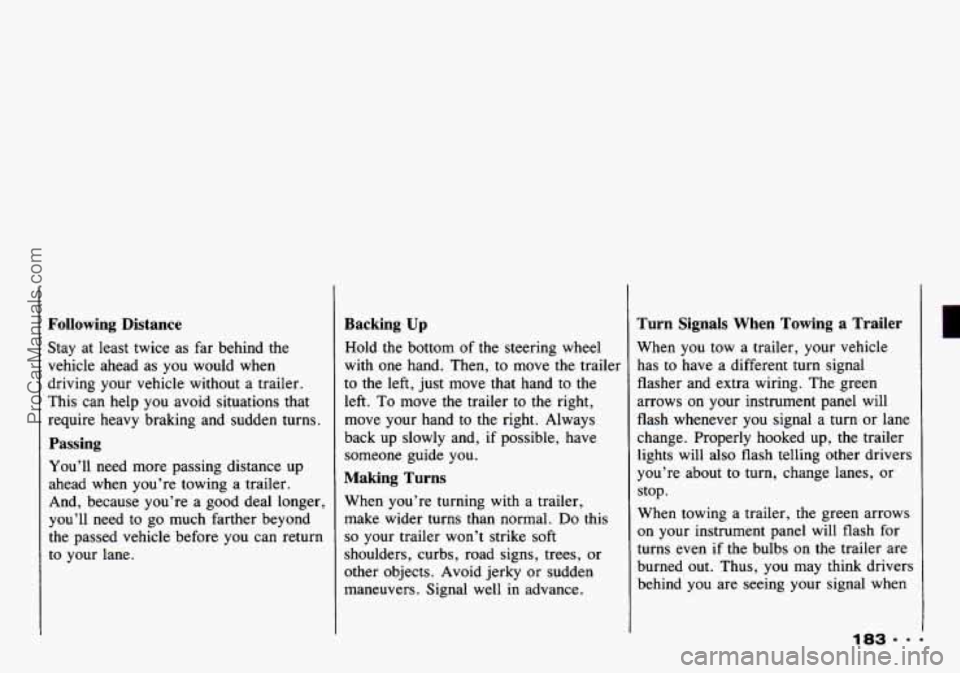
Following Distance
Stay at least twice as far behind the
vehicle ahead as you would when
driving your vehicle without a trailer.
This can help you avoid situations that
require heavy braking and sudden turns.
Passing
You’ll need more passing distance up
ahead when you’re towing a trailer.
And, because you’re a good deal longer,
you’ll need to
go much farther beyond
the passed vehicle before you can return
to your lane.
Backing Up
Hold the bottom of the steering wheel
with one hand. Then, to move the trailer
to the left, just move that hand to the
left.
To move the trailer to the right,
move your hand to the right. Always
back up slowly and, if possible, have
someone guide you.
Making Turns
When you’re turning with a trailer,
make wider turns than normal.
Do this
so your trailer won’t strike soft
shoulders, curbs, road signs, trees, or
other objects. Avoid jerky
or sudden
maneuvers. Signal well in advance.
Turn Signals When Towing a Trailer
When you tow a trailer, your vehicle
has to have a different turn signal
flasher and extra wiring. The green
arrows on your instrument panel will
flash whenever you signal
a turn or lane
change. Properly hooked up, the trailer
lights will also flash telling other drivers
you’re about
to turn, change lanes, or
stop.
When towing a trailer, the green arrows
on your instrument panel will flash for
turns even if the bulbs on the trailer are
burned out. Thus, you may think drivers
behind you are seeing your signal when
ProCarManuals.com
Page 186 of 339
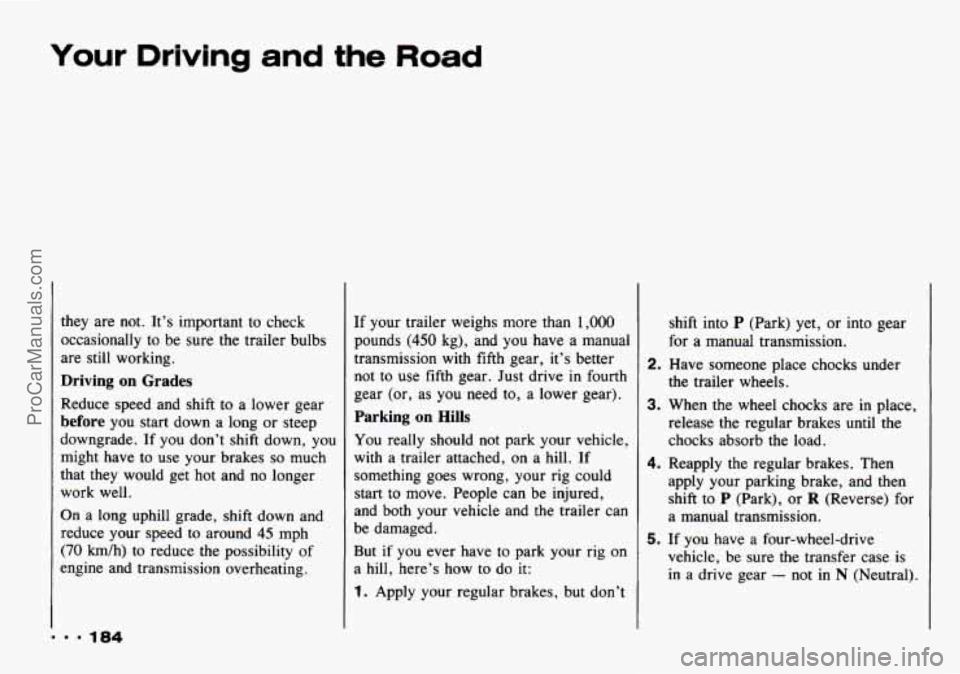
Your Driving and the Road
they are not. It’s important to check
occasionally to be sure the trailer bulbs
are still working.
Driving on Grades
Reduce speed and shift to a lower gear
before you start down a long or steep
downgrade. If you don’t shift down, you
might have to use your brakes
so much
that they would get hot and no longer
work well.
On a long uphill grade, shift down and
reduce your speed
to around 45 mph
(70 km/h) to reduce the possibility of
engine and transmission overheating.
If your trailer weighs more than 1,000
pounds
(450 kg), and you have a manual
transmission with fifth gear, it’s better
not to use fifth gear. Just drive
in fourth
gear (or, as you need to, a lower gear).
Parking on Hills
You really should not park your vehicle,
with a trailer attached, on a hill. If
something goes wrong, your rig could
start to move. People can be injured,
and both your vehicle and the trailer can
be damaged.
But
if you ever have to park your rig on
a hill, here’s how to do
it:
1. Apply your regular brakes, but don’t shift into
P (Park)
yet, or into gear
for a manual transmission.
the trailer wheels.
2. Have someone place chocks under
3. When the wheel chocks are in place,
release the regular brakes until the
chocks absorb the load.
apply your parking brake, and then
shift
to P (Park), or R (Reverse) for
a manual transmission.
vehicle, be sure the transfer case is
in a drive gear - not in N (Neutral).
4. Reapply the regular brakes. Then
5. If you have a four-wheel-drive
... 184
ProCarManuals.com
Page 187 of 339
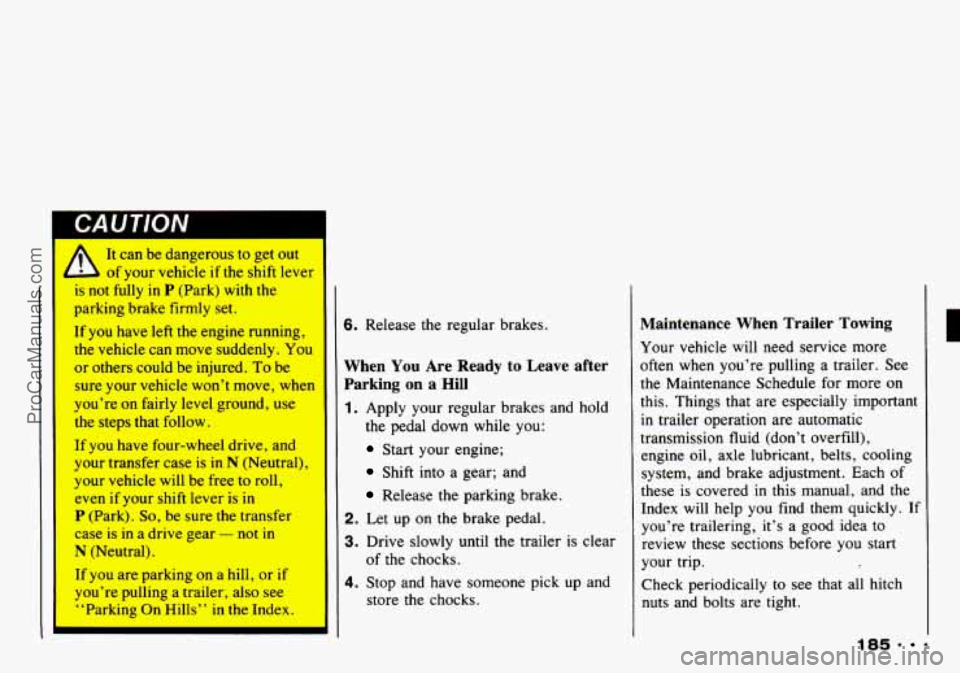
J
It be dangerous tu get out
of your vehicle if the shift lever
is not fully in P (Park) with the
parking brake firmly set.
If you have left the engine running,
the veficle can
move suddenly. You
or others could be injured. To be
sure your vehicle won’t move, when
you’re
on fairly level ground, use
the steps that follow.
If you have four-wheel drive, and
your transfer
case is in N (NeutraI) ,
your vehicle will be free to roll,
even
if your shift lever is in
P (Park). So, be sure the transfer
case is in a drive gear - not in
N (Neutral).
If you are parking on a hill, or if
you’re pulling a trailer; also see
“Parking On Hills” in the Index.
6. Release the regular brakes.
When You Are Ready to Leave after
Parking on a
Hill
1. Apply your regular brakes and hold
the pedal down while you:
Start your engine;
Shift into a gear; and
Release the parking brake.
2. Let up on the brake pedal.
3. Drive slowly until the trailer is clear
4. Stop and have someone pick up and
of the chocks.
store
the chocks.
Maintenance When Trailer Towing
Your vehicle will need service more
often when you’re pulling a trailer.
See
the Maintenance Schedule for more on
this. Things that are especially important
in trailer operation are automatic
transmission fluid (don’t overfill),
engine oil, axle lubricant, belts, cooling
system, and brake adjustment. Each
of
these is covered in this manual, and the
Index will help you find them quickly.
If
you’re trailering, it’s a good idea to
review these sections before you start
your trip.
Check periodically
to see that all hitch
nuts and bolts are tight.
185 9 =
ProCarManuals.com
Page 188 of 339
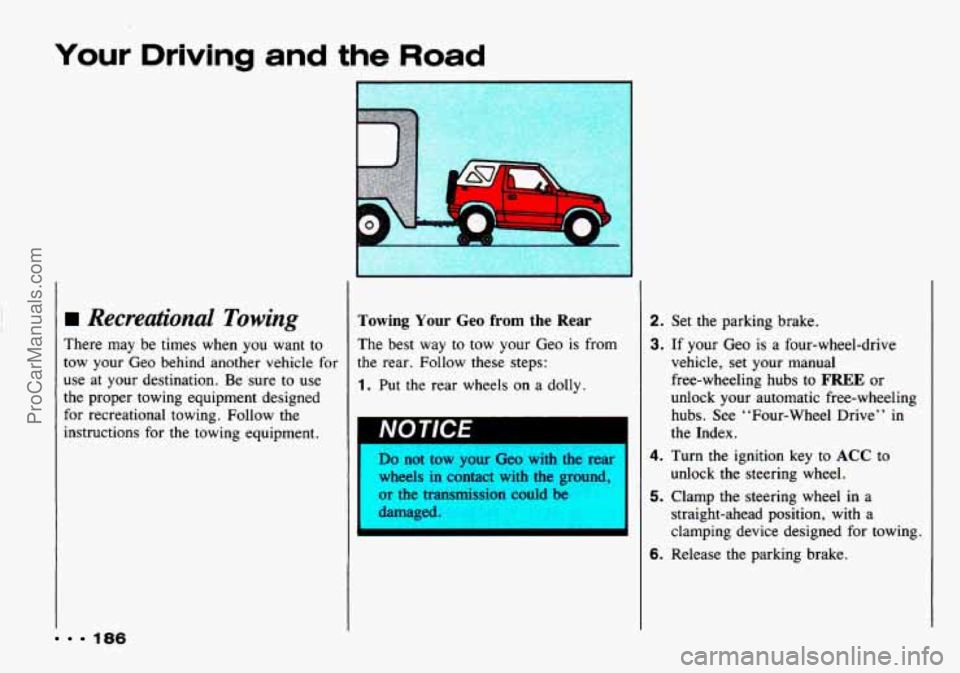
Your Driving and the Road
Recreational Towing
There may be times when you want to
tow your Geo behind another vehicle for
use at your destination. Be sure to use
the proper towing equipment designed
for recreational towing. Follow
the
instructions for the towing equipment.
186
Towing Your Geo from the Rear
The best way to tow your Geo is from
the rear. Follow these steps:
1 . Put the rear wheels on a dolly.
NOTlCE
Do not tow your Geo with the re--
wheels in contact with the grounL,
or
the transmission could be
damaged.
2. Set the parking brake.
3. If your Geo is a four-wheel-drive
vehicle, set your manual
free-wheeling hubs to
FREE or
unlock your automatic free-wheeling
hubs. See “Four-Wheel Drive’’
in
the Index.
4. Turn the ignition key to ACC to
unlock the steering wheel.
5. Clamp the steering wheel in a
straight-ahead position,
with a
clamping device designed for towing.
6. Release the parking brake.
ProCarManuals.com
Page 189 of 339
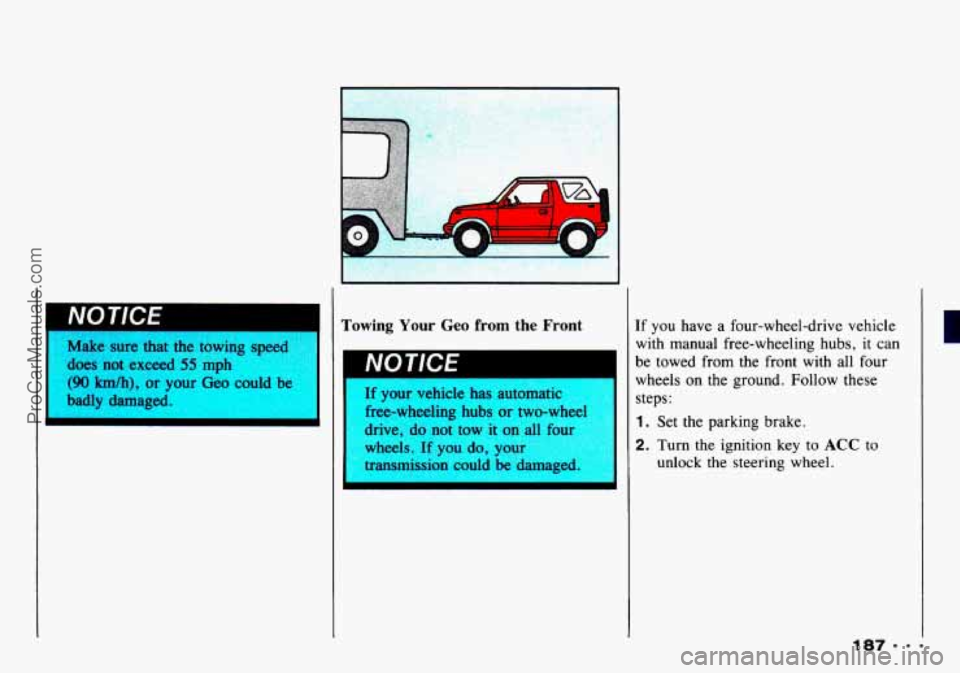
Make sure that the towing speed
dues not exceed 55 mph
(90 km/h), or your Geo could be
badly damaged.
Towing Your Geo from the Front
If your vehicle has automatic
I free-wheeling hubs or two-whet
drive, do not tow it
on all fa
I wheels. If you do, you transmission could be damaged.
I
If you have a four-wheel-drive vehicle
with manual free-wheeling hubs, it can
be towed from the front with all four
wheels on the ground. Follow these
steps:
1. Set the parking brake.
2. Turn the ignition key to ACC to
unlock the steering wheel.
ProCarManuals.com
Page 190 of 339
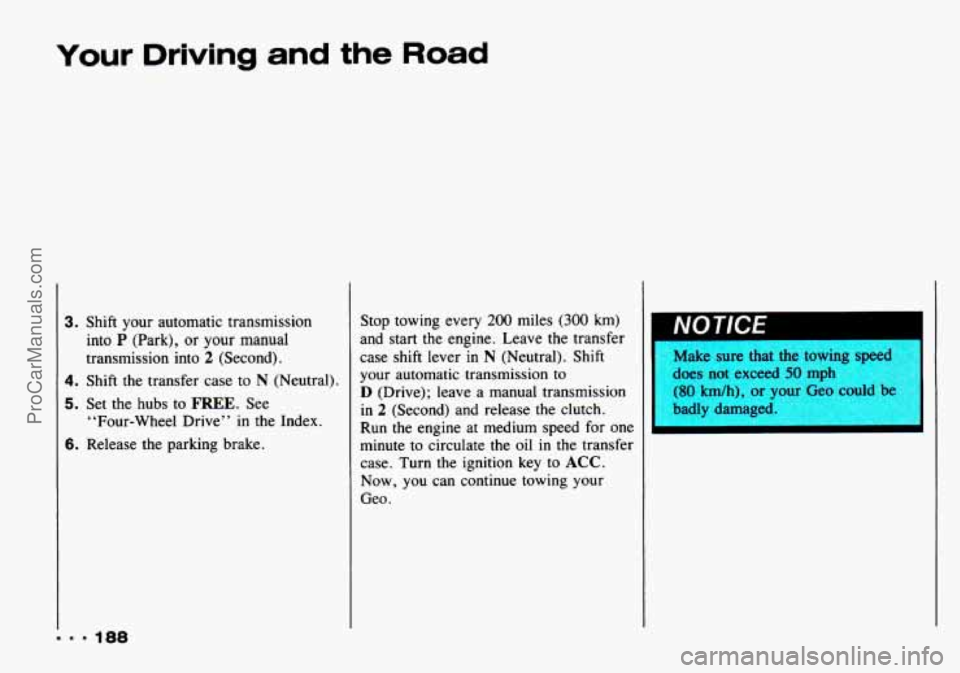
Your Driving and the Road
= - 9 188
3. Shift your automatic transmission
into
P (Park), or your manual
transmission into
2 (Second).
4. Shift the transfer case to N (Neutral).
5. Set the hubs to FREE. See
“Four-Wheel Drive” in the Index.
6. Release the parking brake. Stop towing every
200 miles (300 km)
and
start the engine. Leave the transfer
case shift lever in
N (Neutral). Shift
your automatic transmission
to
D (Drive); leave a manual transmission
in
2 (Second) and release the clutch.
Run the engine at medium speed for one
minute to circulate
the oil in the transfer
case. Turn
the ignition key to ACC.
Now, you can continue towing your
Geo
.
NU I Kt
Make sure that the towing speed
does not exceed
50 mph
(80 km/h), or your Geo could
badly damaged.
ProCarManuals.com